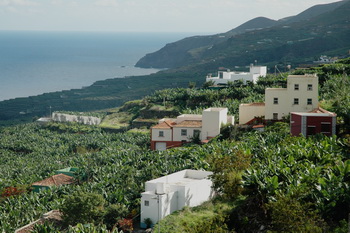
La Palma
Canary Islands
November 2008
Part Three
| |
| HOME |
| About Tenaya |
| About Us |
| Latest Update |
| Logs from Current Year |
| Logs from Previous Years |
| Katie's View |
| Route Map |
| Links |
| Contact Us |
![]()
November 26, 2008
We arrived at Santa Cruz de La Palma the day before yesterday after and overnight voyage from Tenerife. Sailing on a broad reach with winds of 12-20 knots we traveled 148 miles in 22 1/2 hours effortlessly thanks to the windvane.
Six pilot whales crossed our bow shortly after we left Tenerife swam beside us for a few minutes before continuing on their way. Tenaya wanted to move faster than necessary so we took one reef in both the main and jib. Less than half a dozen ships appeared on radar all night and although clouds obscured the stars and miniscule moon we had a very comfortable passage.

The first of many rainbows we saw on La Palma
Comfortable is not the word to describe the conditions in the marina. An enthusiastic swell rolls the few sailboats in the mostly empty marina. Walking on the floating pontoons is like negotiating a hallway during a 6.2 earthquake. Tenaya sways and bucks from side to side and back and forth, straining on the many docklines. Imagining we are in a rolly anchorage, our spirits are not dampened. The pontoons appear shiny new although the normal facilities do not yet exist. A cubicle contains the office and showers and toilets are a bit of a jaunt, beyond rows of lorries waiting for cargo to arrive. Fortunately, the Club Nautico kindly welcomes yachties to use their fine facilities including indoor and outdoor swimming pools.
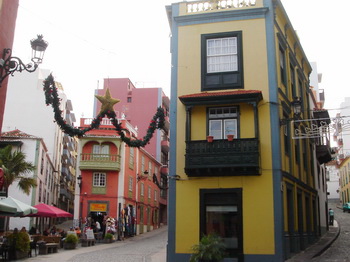
Brightly painted buildings in Santa Cruz
The city center of Santa Cruz is charming. Narrow cobblestone streets lined with colorful buildings are a pleasure to explore.

The churches remind us of the California missions built by Spanish settlers

Not on the beaten tourist path, La Palma escapes many of the trappings of the other islands. The only visitors we encountered were a few German and Dutch hikers in the mountains. We're pretty sure we are the only Americans here. Our small, red VW Fox rental car obediently climbed mountains and negotiated switchbacks, often in the rain, for two days as we saw a good portion of the island.
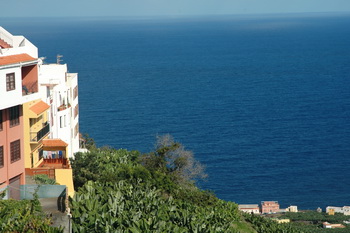
View over banana plantations in Los Sauces
We took a short detour into Los Tilos, a small sub-tropical rainforest declared a UNESCO Biosphere Reserve. Not surprisingly it was raining as we hiked 2.5 km. up the steep ravine to a fantastic lookout.
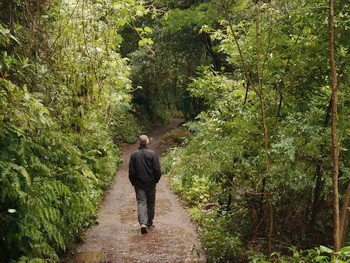
Jim in the rainforest
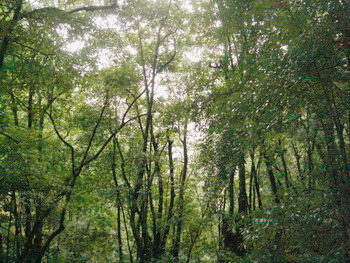
The rainforest contains vast numbers of laurel trees

Hiking the last few meters to the lookout

Partial view from the lookout
.

Known as the Isla Bonita, the Pretty Island, Santa Cruz is the archipelago's greenest island. Plentiful rainfall insures agricultural success and banana plantations are everywhere. The magnificent mountains and steep, deep gorges, plentiful Canary pines and colorful villages set against a sky of bright blue, smoky mist or dark storm clouds add to the beauty.
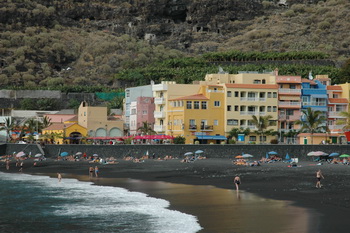
Black sand beach at Tazacorte

Banana exportation is the mainstay of the economy
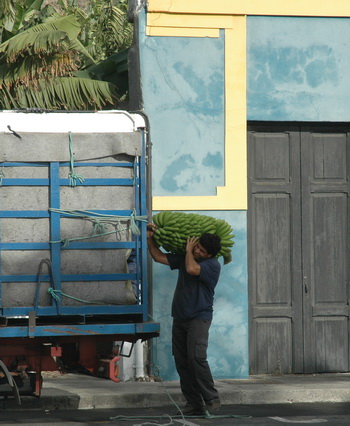
The island has very distinct climates and landscapes. The north is cloudy, wet and green, the western coast is warm, sunny and drier and the south is hot and nearly barren.
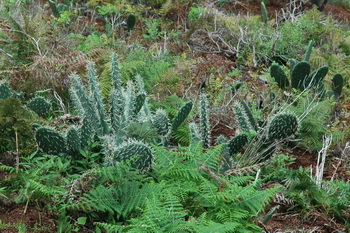
Ferns grow next to cacti in the north
The most significant feature of this endearing island is the question mark shaped caldera in roughly the center. Nearly encircling steep, deep ravines, enormous stone walls 10 kilometers in diameter form the Caldera de Taburiente. In 1825 German geologist Leopold von Buch used the spanish term 'caldera' meaning cauldron, to describe what he assumed to be a massive volcanic crater. The term stuck and became the standard term to describe volcanic craters throughout the world. This caldera was not the result of one massive eruption though, rather it has been slowly excavated by erosion over the millennia.
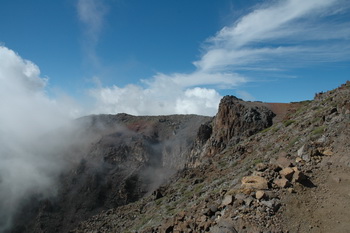
A portion of the edge of Caldera de Taburiente from Roque de los Muchacos, the island's highest point at 2426 meters
La Palma is very young, geologically speaking. It has experienced 15 major volcanic eruptions in the last 500 years, the last being in 1971. This recent activity has been in the southern part of the island.

Rim of Volcan San Antonio which erupted in 1949. Canary Pines have taken root in the caldera.

Canary pines are incredibly hearty. Within 3 months of a forest fire new needles sprout from charred trees.
The atmospheric conditions are excellent over La Palma and for 30 years astronomers from all over the world have come here to peer into the universe. The Observatario Astrofisico de la Palma is a cluster of domes, antennae and sensors on the edge of the Parque Nacional de la Caldera de Taburiente. Several countries are participating in the research. One night a year all the lights of the island are turned off to allow experiments to take place. What a good excuse for a party!
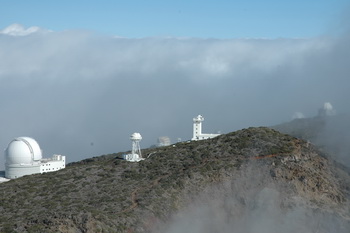
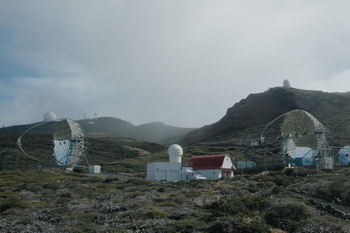
Radio wave antennae and telescopes dot Roque de los Muchacos

.